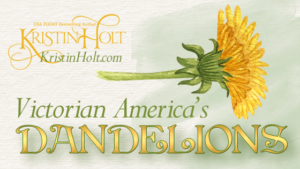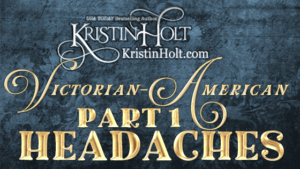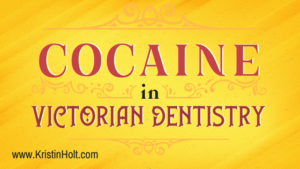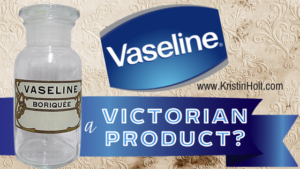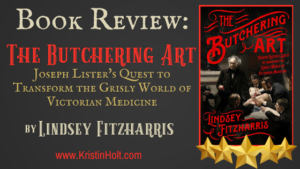.
Victorian-American Headaches: Part 4
.
In my most recent Headache article, I shared the 1880s craze for antipyrin, a favored ingredient in headache specifics. Today, in Victorian-American Headaches: Part 4, I’ll focus on “medicines” that were headache remedies in the 19th Century United States.
.
Cures, Pills, Medicines
Victorian-American Headaches: Part 4
Today’s exploration through Victorian-American Headaches (Part 4) contains a focus on Victorian-era newspaper advertisements for headache remedies. Whether for pills delivered by mail or remedies for sale at the corner drugstore, Victorians apparently loved their headache medicines. Don’t forget that Coca-Cola began as a headache specific at the corner druggist.
I’ve read several novels with a “headache powder” or two… so this “headache specific” is included among the vast list of Victorian-era “Patent Medicines.”
.

“Something Lacking” — as in chastisement from a headache sufferer. Why do you not advertise your headache powders? From Philadelphia Call, and printed in Kellogg’s Wichita Record of Wichita, Kansas on April 27, 1895.
.
No Aspirin
.
Today, headache sufferers are trained to reach for OTC (over-the-counter) non-steroidal anti-inflammatory drugs. Like aspirin. Or Tylenol.
So naturally, I had to dive into aspirin’s history. What did druggists put in that stone pestle of theirs, to make a “headache specific”? Just what ingredients belonged in a headache powder?
Aspirin? Yes? Victorian-American Headaches: Part 4.
Apparently not.
An examination of American medical literature reveals that in the 19th century, headache was seen as an important diagnostic sign, and served to demonstrate medicine’s concern with explanations, rather than its therapeutic effectiveness. Headache treatment was therefore directed at causes rather than its chief symptom: painkilling was regarded as empirical, quackish, and sectarian. Even when nonnarcotic analgesic drugs, such as phenacetin and aspirin, were introduced towards the end of the century, physicians tended not to use them for headache.
.
~ Headache: The Journal of Head and Face Pain
(emphasis added)
.
Ads in Vintage Newspapers
.
Each advertisement contains the original source (newspaper, city of publication, and date). As remedies are so diverse and with a wide swath of self-proclaimed uses and conditions the medicine will eradicate, it seems silly to try and group the ads by “type.” Instead, I’ve listed the headache remedy advertisements in order by date of publication.
.

Cephalic Pills cure sick headache. For sale by individual mail-order, advertised in New England Farmer of Boston, Mass. on November 24, 1860.

Part 2 of 2: Cephalic Pills cure sick headache. For sale by individual mail-order, advertised in New England Farmer of Boston, Mass. on November 24, 1860.
.

Plantation Bitters, advertised in form of a doctor’s endorsement within an article about headaches. Atchison Daily Patriot of Atchison, Kansas on June 7, 1870.
.

Radway’s Ready Relief (R.R.R.) advertised in Chicago Tribune of Chicago, Illinois on December 9, 1876. (Part 1 of 2)
![Kristin Holt | Victorian-American Headaches: Part 4. R.R.R. Pain Relief, Part 2 of 2. Ad from Chicago Tribune, December 9, 1876. Kristin Holt | Victorian-American Headaches: Part 4. R.R.R. Pain Relief, Part 2 of 2. Ad from Chicago Tribune, December 9, 1876. Image Text reads: "IN FROM ONE TO TWENTY MINUTES. No matter how violent or excruciating the pain, the Rheumatic, Bed-ridden, Infirm, Crippled, Nervous, Neuralgic, or prostrated with disease may suffer RADWAY'S READY RELIEF WILL Afford Instant Ease. Inflammation of the Kidneys, Inflammation of the Bladder, Inflammation of the Bowels, Mumps, Congestion of the Lungs, Sore Throat, Difficult Breathing, Palpitation of the Heart, Hysterics, Croup, Diptheria, Catarrh, Influenza, Headache, Toothache, Neuralgia, Rheumatism, Cold Chills, Ague Chills, Chillblains, and Frost Bites. The application of the Ready Relief to the part of parts where the pain or difficulty exists will afford ease and comfort. Twenty drops in half a tumbler of water will, in a few minutes, c cure Cramps, Pains, Sour Stomach, Heartburn, Sick Headache, Diarrhea, Dysentery, Colic, Wind in the Bowels, and all internal pains. Travelers should always carry a bottle of RADWAY'S READY RELIEF with them. A few drops in water will prevent sickness or pains from change of water. It is better than French Brandy or Bitters as a stimulant. FEVER AND AGUE. Fever and Ague cured for fifty cents. There is not a remedial agent in the world that will cure fever and ague, and all other malarious, bilious, scarlet, typhoid, yellow and other fevers (aided by Radway's Pills) as quickly as Radway's Read [sic] Relief. Fifty cents per bo [sic]. Sold by Druggists".](https://www.kristinholt.com/wp-content/uploads/2019/10/R.R.R.-PAIN-RELIEF.-part-2.-Chicago-Trbune.-9-Dec-1876.png)
R.R.R. Pain Relief, Part 2 of 2. Ad from Chicago Tribune, December 9, 1876.
.

Dr. C.W. Benson’s Celery and Chamomile Pills to cure sick headache, nervous headache, neuralgia, nervousness, sleeplessness. Published in The Eaton Democrat of Eaton, Ohio on July 19, 1877.
.
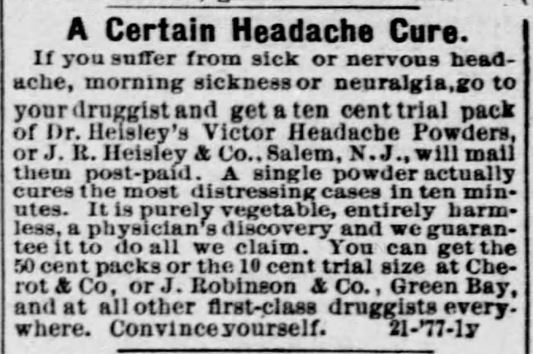
Dr. Heisley’s Victor Headache Powders, advertised in Green Bay Advocate of Green Gay, Wisconsin. December 20, 1877.
.

Kellogg’s Columbian Oil [sic] for a variety of ailments, including headache, toothache, earache, neuralgia and beyond. Advertised in Steuben Republican of Angola, Indiana on January 5, 1881.
.
Speaking of Advertisements…
.
Note the format of ads in the 1860s and 1870s. Paragraph format. Endorsements. Authoritative speech from “doctors.” Yet in the 1880s, ads became more of a visual feast. And more of a blatant advertisement. Note the gorgeous use of typography in the following dandelion tonic. Not only does the ad catch the eye, it also makes bold claims about various ailments eradicated by its use.
.

Leis’ Dandelion Tonic: The Great Blood & Liver Purifier. A Sure Cure for Sick Headache. Published in The Lyons Republican of Lyons, Kansas on Aug 25, 1881.
.
.

Sick Headache Cure- Carter’s Little Liver Pills. Advertised in Manhattan Mercury of Manhattan, Kansas on September 18, 1889.
.

Carter’s Little Liver Pills advertised for Sick Headache in Pittsburgh Dispatch of Pittsburgh, Pennsylvania on February 8, 1891.
.

Beecham’s Pills, advertised in The Salt Lake City Tribune on March 15, 1891.
.

Carter’s Little Liver Pills Cure Sick Head Ache. Ad from The Meade Republican of Meade, Kansas on September 30, 1891.
.

Krause’s Headache Capsules— Warranted, For sale by Smoot Drug Co. Ad in The Daily Enquirer of Provo, Utah on April 27, 1893.
.

Carter’s Little Liver Pills AND Burdock Blood Bitters. Advertised in Star-Gazette of Elmira, New York on February 23, 1893.
.

Hoods’ Sarsaparilla Cures Dull Headaches. Advertisement (and endorsement) published in The San Francisco Call on February 19, 1894.
.

Quote from Dr. Wright, within his popular treatise on headache, “I am convinced that it is unwise ever to neglect a headache.” See this quote within the following newspaper ad for Dr. Miles’ Restorative Nervine.
,

Illustration (logo?) of Dr. Miles’ Restorative Nervine: The Only Remedy For Nervous Diseases Admitted to The World’s Fair.

Dr. Miles’ Nervine Medicine, advertised in Ellsworth Reporter of Ellsworth, Kansas on March 22, 1894.
.
The company selling Dr. Miles’ Restorative Nervine did more than ensure entrance to The World’s Fair and all the sales that exposure to their product would bring. They took out a full-page newspaper advertisement (also in the Ellsworth Reporter of Ellsworth, Kansas on the same day (March 22, 1894):
.
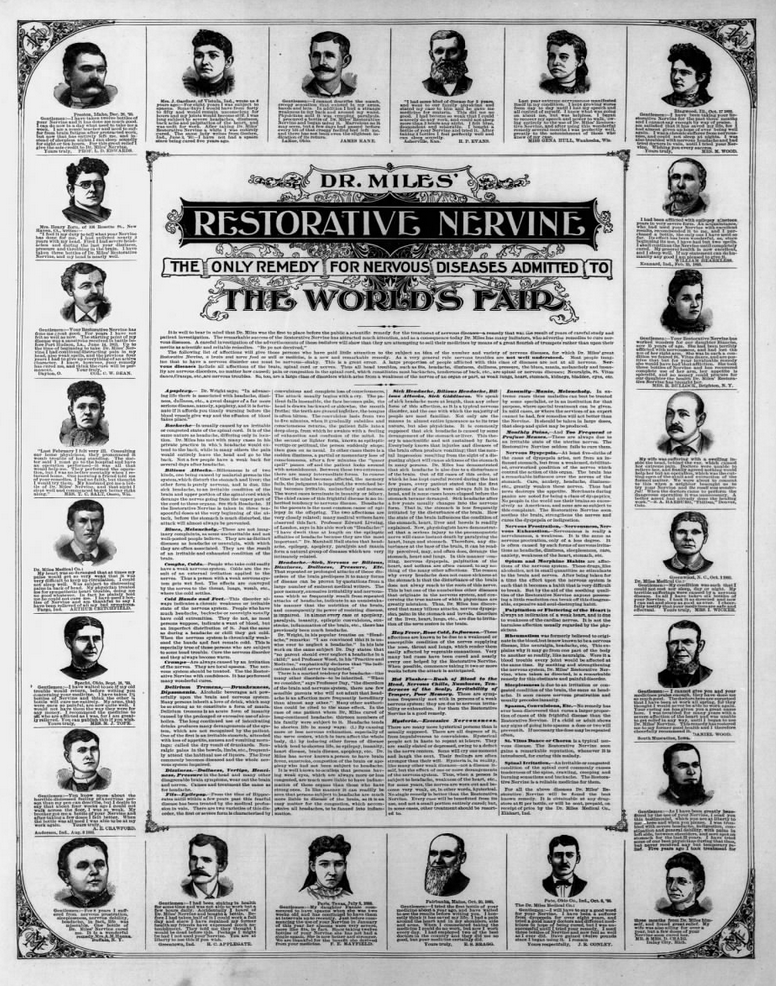
Full-page advertisement (with numerous endorsements), illustrated. Dr. Miles’ Restorative Nervine: The Only Rememdy for Nervous Diseases Admitted to The World’s Fair. Published in Ellsworth Reporter of Ellsworth, Kansas on March 22, 1894.
.

Advertisement for Royal Headache Tablets (R.H.T.), advertised in News and Observer of Raleigh, NC on June 18, 1899.
.

Anti-Cephal-Algine. Leads all Headache Remedies. A newspaper full-half-page advertisement in News and Observer of Raleigh, North Carolina on June 18, 1899.
.

Syrup of Figs as a headache remedy. Published in Carlisle Evening Herald of Carlisle, PA on Oct 30, 1899.
.

Wright’s Paragon Headache Remedy, advertised in The Los Angeles Times (Los Angeles, California) on June 16, 1900.
.

Dr. Humphrey’s Specifies Cure by acting directly upon the disease, without exciting disorder in any other part of the system. Various numbered preparations are assigned to specific ailments. Headache is #9, for 25c. Dr. Humphrey’s Manual of all Diseases at your druggist or mailed free. Sold by druggists, or sent on receipt of price. Humphreys’ Med. Co., Cor. William & John Sts, New York. From Salina Daily Republican-Journal of Salina, Kansas on September 18, 1900.
.

Dr. Miles Anti-Pain Pills. Illustrated Advertisement from The Hays Free Press of Hays, Kansas on July 20, 1901.
.

Krause’s Headache Capsules advertisement in The Topeka State Journal of Topeka, Kansas on November 27, 1901.
.

Dr. King’s New Life Pills. Advertised in El Dorado Daily Republican of El Dorado, Kansas. November 25, 1901.
.
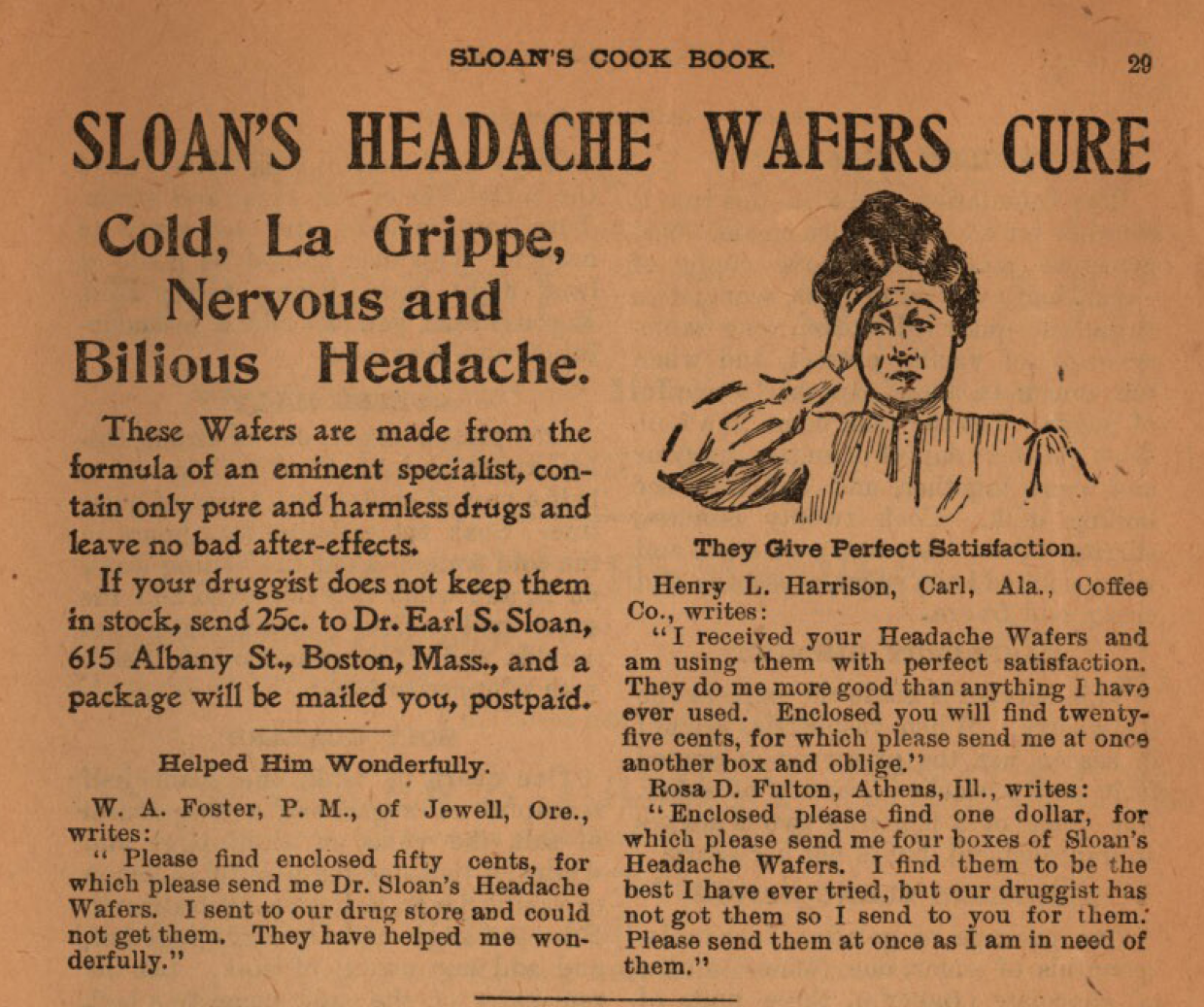
Sloan’s Headache Wafers Cure, ad within Sloan’s Cook Book and Advice to Housekeepers, published 1905.
.
Conclusion
.
Did you notice the lack of ingredient listings? Manufacturers might claim “all vegetable” and “harmless,” but none were required, then, to disclose what the products actually contained. The nineteenth century would officially close before anyone decided to offer a voluntary program of drug approval, beginning in 1905 and lasting until 1955.
In 1911, in U.S. v. Johnson, the Supreme court ruled that the 1906 Food and Drugs Act did not outlaw false medical claims. Great. Snake Oil Salesman, Rejoice!
Desperate people no doubt turned to patent medicines (and other “commercially available” compounds sold as medicine) for cures. Even when promises seemed too good to be true, people in pain must have sought something–anything!–that might alleviate the pain. People do the same thing today.
Remember, too, that legislation that protected the public from contamination of food, drink, and medication was only beginning. People may have been aware of the risks with meds, as they certainly were (becoming) with food and drink. Even if individuals weren’t aware that bacteria and fillers contaminated foods, nineteenth century U.S. residents lived with indigestion and biliousness. (Cook books, newspaper advertisements, diaries, letters, etc. all paint this picture.)
.
Up Next
.
.
In previous blog articles in this Headaches series, I’ve covered medical explanations about why people suffer from headaches. Including causes, lifestyle choices (for avoiding headaches), and “patent medicines.” Part 5 will contain a focus on how Sundays lead to headaches. (And more about the mysterious headache powders.)
.
Invitation
.
Do you have thoughts to ad?
Do you own a vintage medicine bottle? Might you share a photo with us?
Please scroll down and comment. We value your thoughts!
.
Related Articles
.

When Coca-Cola debuted (1886), the beverage was sold at druggists as a “brain tonic” and “headache specific.”
.
Updated June 2022
Copyright © 2019 Kristin Holt LC


